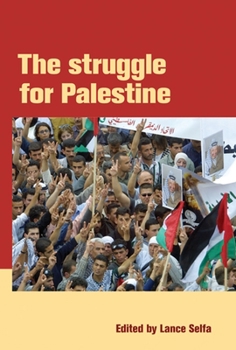The Struggle for Palestine
Select Format
Select Condition 
Book Overview
Leading international solidarity activists offer insight into the ongoing struggle for Palestinian freedom and justice. Includes Anthony Arnove, Naseer Aruri, David Barsamian, Paul D'Amato, Phil Gasper, Toufic Haddad, Tikva Honig-Parnass, Rania Masri, Tanya Reinhart, Edward Said, and Ahmed Shawki.
Format:Paperback
Language:English
ISBN:1931859000
ISBN13:9781931859004
Release Date:June 2002
Publisher:Haymarket Books
Length:256 Pages
Weight:0.70 lbs.
Dimensions:0.5" x 5.5" x 7.7"
Customer Reviews
3 ratings
A must read for understanding the Middle East
Published by Thriftbooks.com User , 18 years ago
There simply is no better book for understanding the history of the conflict in Palestine and Israel, and the US role in that conflict. It also contains a compelling, provocative argument for a unified country embracing Jews and Palestinians alike, and for the connections with the struggle against dictatorships throughout the region.
the most useful book I have found on Palestine and Israel
Published by Thriftbooks.com User , 19 years ago
This was the first book I read about Israel and Palestine, as a college freshman, and I found it a very comprehensible introduction. In the past two weeks (July 2006), as Israel has invaded Gaza and Lebanon, I have re-read the book and been stunned by how much I have learned reading it a second time (and after, four years later, having now read many other sources on the conflicts in the Middle East as well). This book has been very helpful for me in being able to understand what is happening in the world. It is still the best book I have found on Israel and Palestine. One of the things I most appreciate about it is that the different chapters and contributors all approach the issue from different angles: - Was Israel founded to counter anti-Semitism? (Actually, to my great surprise when I read it for the first time, Zionist leaders actually made deals with the Nazis to encourage more Jews to leave Europe and move to Palestine! This is in the book's first essay, "Zionism: False Messiah," with many more examples of how Zionist leaders prioritized their political goal of building a Jewish-only state above fighting anti-Semitism) - Why does the US offer so much support to Israel and how did this relationship evolve? How is it related to US support for other regimes in the Middle East, such as Egypt and Saudi Arabia, and in the past, Iran and Iraq? - What was the "peace process" about and why did it fall apart? What were Israel, Arafat and the US each hoping to achieve from it? - Where did the different movements in Palestine (PLO, Hamas, Fatah, etc) come from and how are they different from each other? - What would Palestinian liberation look like and what kind of movement in the Middle East would win it? Is it possible for Arabs and Jews to live together without racism? How would we get there? ...and many more; those are just some examples. I find it very helpful that the book discusses so many aspects of the situation in the Middle East. It also includes interviews with and statements from Palestinian and Israeli activists who have resisted Zionism and Israeli colonialism. In short, I can't recommend this book more highly for anyone trying to understand the conflicts in the Middle East. I've lent my copy to a number of friends over the years, and I hope more people will buy and learn from this book.
Great Reference Guide for Anti-Zionists
Published by Thriftbooks.com User , 22 years ago
This book really holds it down for anti-Zionists. It is aimed at strengthening and sharpening our skills as pro-Palestinian activists. It has over a dozen contributors who approach the subject from several different left-wing perspectives. Especially useful for activists is Phil Gasper's chapter, Mostafa Omar's chapter, and the interviews with Tivka Honig-Parnass, Toufic Haddad and Edward Said.Hadas Thier has an excellent chapter outlining why Ariel Sharon, the "crime" minister of Israel, is a war criminal.I am very happy with this book, and know that several people in my town have ordered it and also found it engaging.






